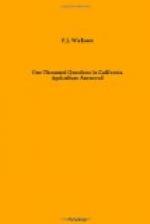General schemes of rotation are hard to work out in California. They must be locally revised according to the local temperature conditions and the local market also. We should endeavor to find out what has been successfully grown on similar lands to those which you have in mind and arrange the rotation on that basis, from what we knew of the relation of the different plants to soil fertility, etc. You cannot make out a satisfactory local scheme for the seven counties in southern California, because of the widely different behavior of the separate plants in the different parts of the district. You can hardly work on the basis of soil character: moisture supply and temperatures are more determinative. Surely you should make a scheme for irrigated land different from that for dry land, and it could not only be a longer rotation, but many more plants would be available for its service.
Berseem?
Berseem has been introduced into this country from Egypt, and would like to know if it has been used in California, and if it has came up to expectations.
Berseem is an annual clover supposed to grow only during the summer time. It has been tried widely in California, but practically abandoned because it will not grow during the rainy season. It is in no way comparable to alfalfa, which is a deep rooted perennial plant, nor would it be comparable with burr clover as a winter grower on lands which have a moderate amount of water.
Heating and Fermentation.
Please explain why dampness will cause anything like hay, Egyptian corn or other like products to heat.
Heating is due to fermentation, which means the action upon the vegetable substance of germs which begin to grow and multiply after their kind whenever conditions favor them. The earlier stages of this action is called “sweating,” and it is beneficial as in the case of hay, tobacco, dried fruits, etc., as is commonly recognized — resulting in what is known as curing — and it is the art of the handler of such products not to allow the action to go beyond what may be called the normal “sweating.” If not checked by proper handling, which involves drying, cooling, etc., fermentation will continue, and other germs will find conditions suitable for them to take up their work of destruction, and this new action produces higher temperature still, and if not checked by cooling or drying or otherwise making the substance inhospitable to them, “heating” will result, and thence onward rapidly to decay, if they have everything their own way.
Moonshine Farming.
What influence, if any, has the moon on plant growth? Are there any reliable data of experiments available?
Very prolonged investigation by the Weather Bureau determined that no difference was found in planting in different phases of the moon. If we paid any attention to it, we should plant in the dark of the moon, so as to get the plants up so that they could use the little more light which the moon gives. It is, however, more important to have the soil right than the moon.




